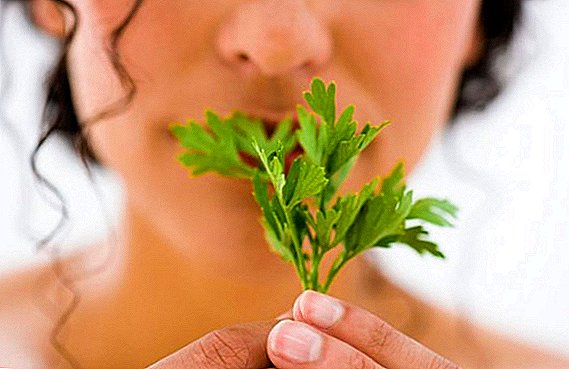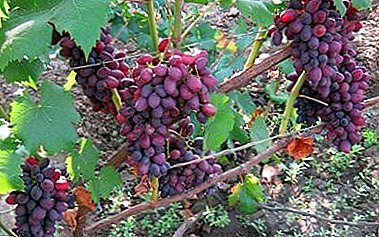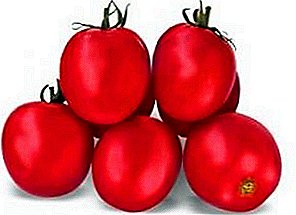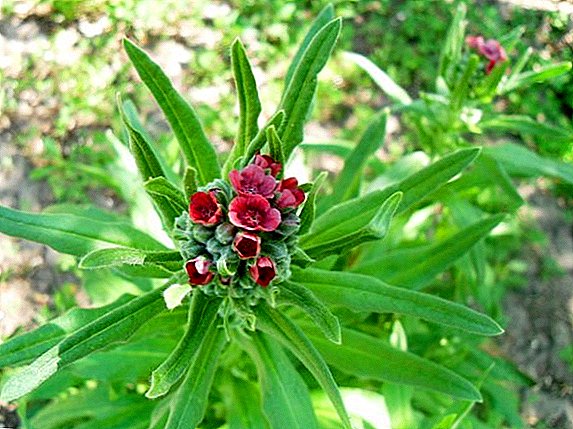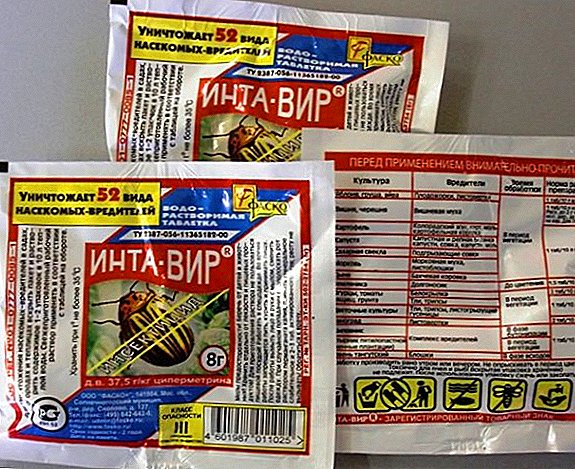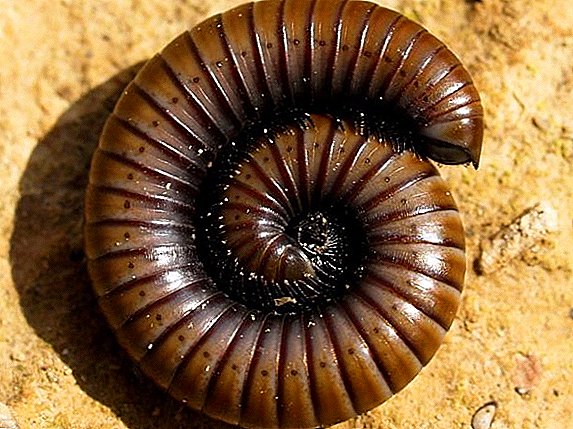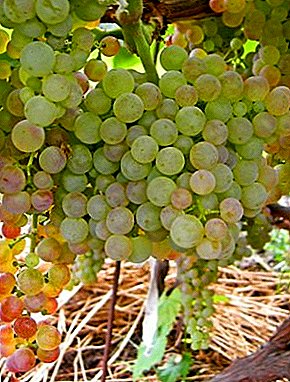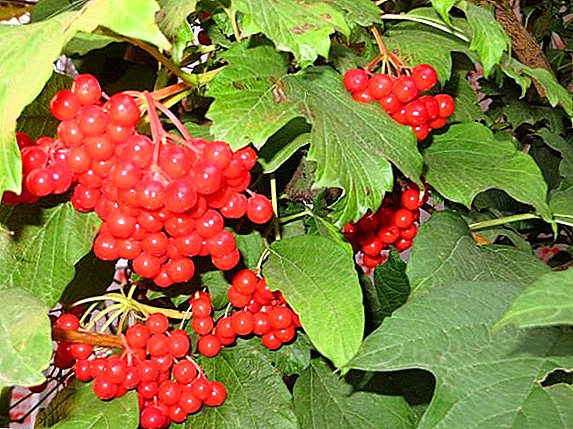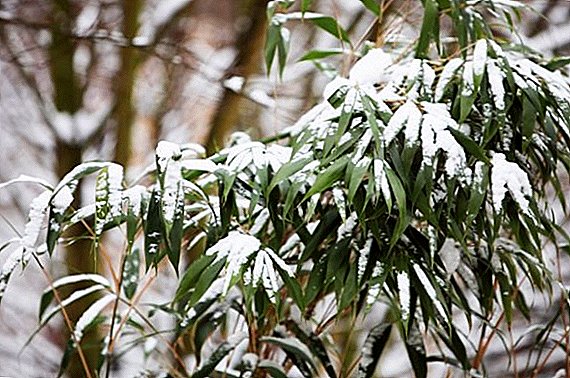 Speaking of bamboo, we present a southern tropical plant completely unsuitable for the conditions of our latitudes.
Speaking of bamboo, we present a southern tropical plant completely unsuitable for the conditions of our latitudes.
However, there are species and varieties of bamboo, which are not afraid of low temperatures and are successfully grown in open ground.
What is this plant and how to grow it - discuss in this article.
What is bamboo
Bamboos are a huge family of cereals, to which more than a thousand species belong. All of them are evergreen, almost all grow to large sizes. In the family there are herbaceous, creepers with climbing or climbing branches and plants with thick lignified shoots.
For decorative purposes, they also cultivate such cereals: pennisetum, miscanthus, horsetail tail, fescue, cortaderia, feather grass, blue and reed minnows, imperator cylindrical, bristles, soddy pike.
Most species prefer the climate of the tropics and subtropics, moist shady jungles, some grow and develop in harsh conditions, for example, in the Kuril Islands, in the Himalayan mountains and the Andes on the border with snowy peaks.

The application of the plant is quite diverse, its various parts are used in such industries:
- the medicine;
- cooking;
- building;
- gardening (landscape design);
- furniture industry;
- light industry (haberdashery, household items, tools, textiles);
- raw materials industry.
Did you know? Japanese samurai onions were made from bamboo stalks using complex processing. Today, the same technology produces sports onion equipment.
Features
Bamboo has a number of properties that distinguish it from other plants:
- incredible strength of the stems. In his quest to germinate, he can even split a stone that he finds in the way;
- rapid growth The highest growth rate belongs to the phyllostachis madake species - 120 cm per day;
- the least studied bloom. Most species very rarely bloom once every 20-60 years, but they all bloom at once and die immediately after fruiting. True, only the aboveground part of the plant dies off, and the rhizome is able to increase the new generation.

Types and varieties of bamboo
Consider the most interesting for growing plants of this family.
Saza
Bamboo is resistant to cold, common in Japan, Korea, Sakhalin, the Kuril Islands, in the mountains of China.
Strong, cylindrical shoots, woody at the bottom, grow to three meters. The stem of the marsh-green color, about one centimeter in diameter, is carried by single branches with leaves at the ends.
Learn how to subdivide ornamental plants.
Leaf plate - Up to half a meter long, wide, oval. By autumn, the edges of the leaves dry up. Blooms rarely, inflorescence - a whisk, consisting of spikelets.
Saza is used in weaving baskets and light furniture, in agriculture it is used to fix the soil on the slopes and along the banks of rivers.
The most common varieties of saz that can be grown in mid-latitudes in open ground:
- Kuril;

- Wich;

- long-spike.
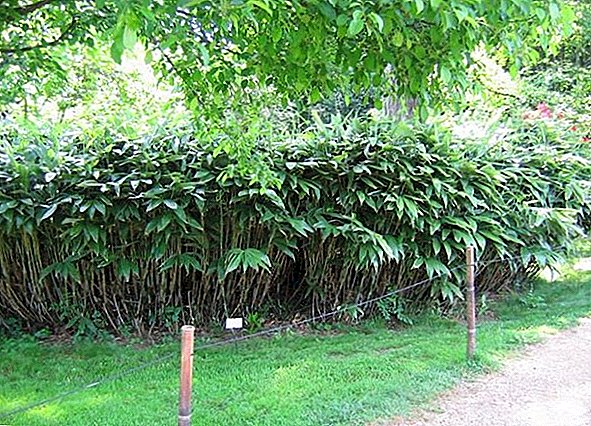
Fargesia
Fargesia, originally from China, is common on its mountain slopes. Evergreen, like all bamboos, grows from half a meter to two meters, grows bush-like. The shoots are thin, depending on the variety of brownish, green or reddish hue.
Check out the list of the best ornamental shrubs for the garden.
On numerous shoots develop branches with long and narrow bright green leaves. In the autumn period, the leaves become yellowish. It is adapted to our latitudes, withstanding cold temperatures up to -30 ° C, the fargesia is brilliant, or rather, its varieties are:
- "Eisenach";

- "McClure";

- "Nymphenburg".

Phillostahis
Phyllostachis grows on wet, but not marshy ground in China, Japan, Europe, Crimea, America. One of the cold-resistant species, can withstand temperatures up to -18 ° C. It grows thickets, growing up to 20 meters, stem diameter up to 15 cm. Young shoots are bright green in color, as they age, they turn yellow.
Check out the list of the best ornamental herbs for flower beds.The leaves are narrow and long, on short petioles. This type is the record for growth. Blossoms, reaching 50 years of age, inflorescences - fluffy panicles.
Popular varieties and varieties of filostahis:
- "bissetii";

- "nigra";
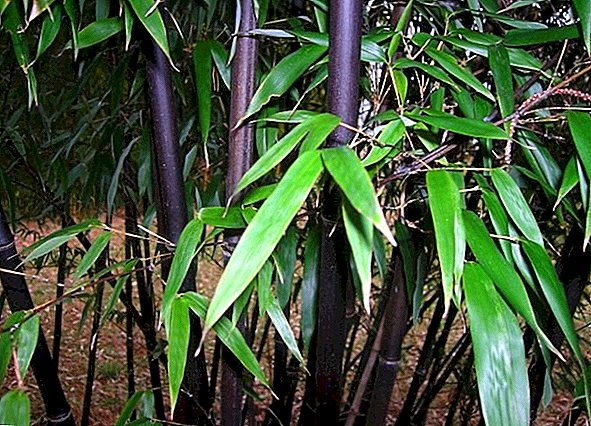
- "aurea";

- "Green Perfume".

Did you know? From the leaves of phyllothachis "bisset" they brew a delicious and healthy tea.
Playoblasts
A species originally from Japan, growing in China and Vietnam. The people call mnogovetochnik, because of the thick undergrowth that it forms, growing. In nature, it grows to a meter and higher, but in the middle lane - up to 60 centimeters.
The shoots are thin, grow in a heap, leafy. The foliage is elongated and narrow, up to 30 cm, it grows so thickly that the petioles and twigs behind it cannot be seen. Varieties can be colored in different shades:
- golden;
- yellow green;
- bluish;
- bright green.
- Simone;
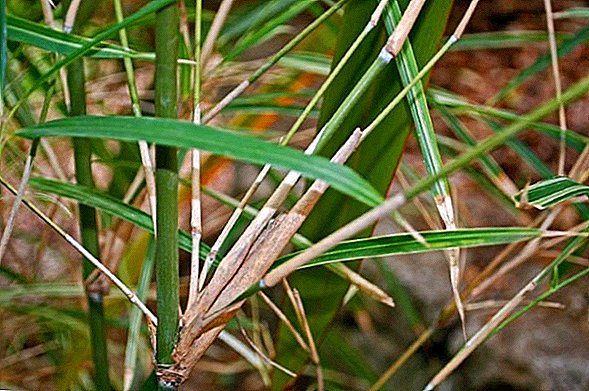
- green stripes;
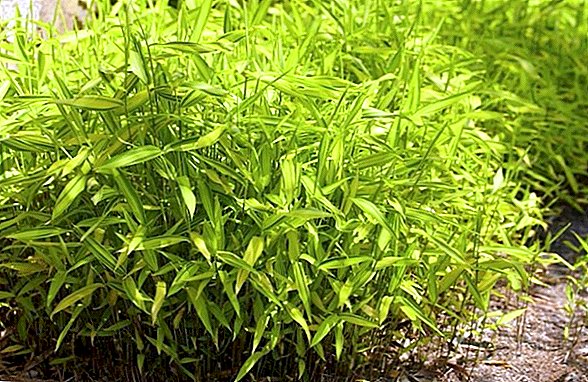
- Forchuna;
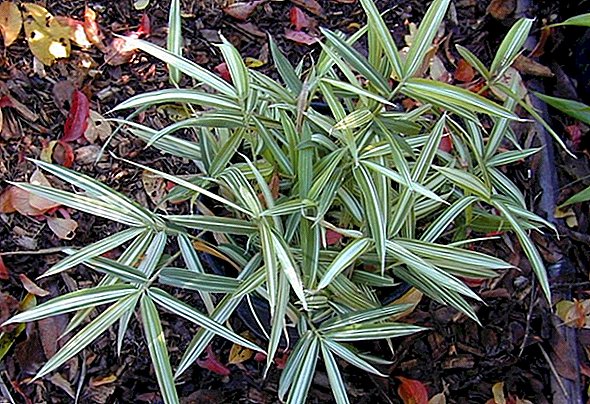
- silver.
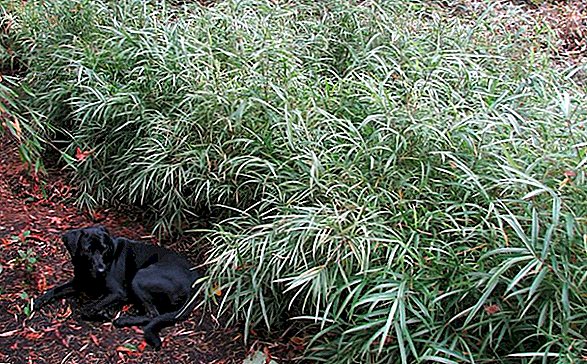
Bamboo ordinary
The most common plant species, lives mainly in tropical forests of Asia, Africa, Madagascar, USA. In cold climates, the plant is best grown as a pot plant, since it can withstand only not very low temperatures of -3 ° C.
Learn about the nuances of choosing plants for hedges.
Growing, forms not too dense thickets of strong stems up to twenty meters tall. The leaves grow thickly, the plates are covered with a light nap, in the shape of an irregular oval, pointed at the end.
In the culture of such popular types:
- green stem;
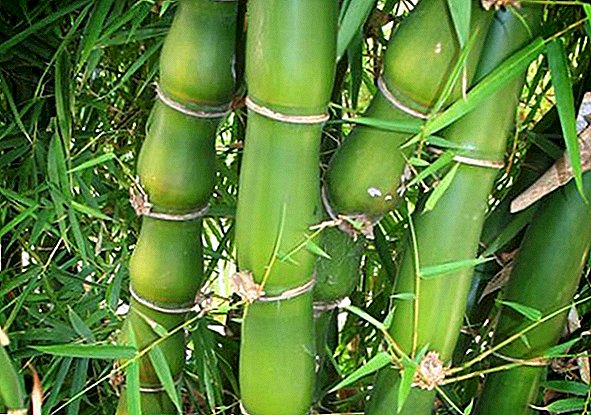
- gold;
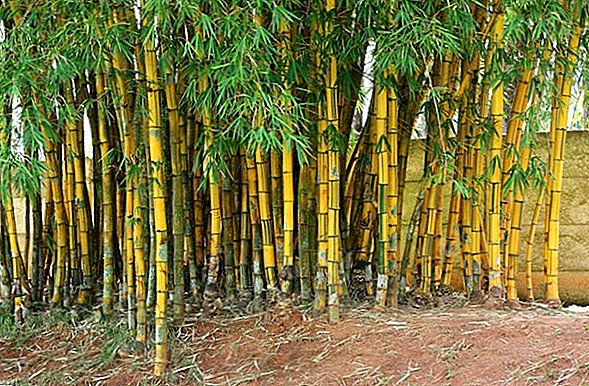
- Wamin three meter.
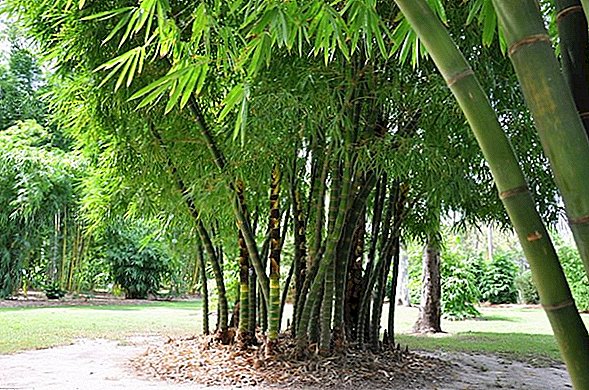
Did you know? The bamboo bridge across the Ming River in China, built in the third millennium of our era, is still in use. Its length - 320 meters, suspended construction, bamboo cables are used as supports.
Bamboo planting
If you are going to plant bamboo on your plot, take care of the choice of neighbors. It can be:
- other decorative cereals;
- host;
- ferns;
- astilba.
Choosing a place on the site
Land for landing is best to choose the south-east or south-west, sheltered from the wind. This may be a closed patio, a place near a high solid fence, the ideal place would be a place near a reservoir.
There is no special requirement for the composition of the soil in bamboo, the only type of soil that is not suitable for it is heavy clay soil. Acidity is desirable at around 6 pH, sufficient moisture and nutrition, otherwise irrigation will have to spend more time.

Conditions
Since bamboo is more of a tropical plant, it requires conditions that are close to natural. It is not advisable to plant in the sun, despite the resistance to heat, the leaves from the direct rays of the sun fade. In strong heat over + 25 ° C, it is desirable to spray the foliage to increase the humidity of the air.
Learn how to grow jujube, actinidia, eucomis, arizema, pomegranate, annonu, cofe, hymenocallis, anguria, asimina, feijoa.
Landing
Best time to land - interval from April, when the soil is well warmed up, to June. Sapling before planting with the tank is placed in water to remove air. After the air bubbles cease to appear, it is lowered into the prepared pit.
The bamboo pit is prepared twice as much as the root system of the seedling. The bottom is covered with a layer of garden soil with humus in equal parts. The seedling is lowered onto the mound and filled with the same mixture as at the bottom of the pit. Powder the roots, ground rammed, vyminaya air layer. After planting spend abundant watering.

Watering
At first, the moisture-loving sapling is watered frequently and abundantly, especially if there is no precipitation. When growth begins, watering is reduced to two times a week. In the presence of precipitation, watering is not needed.
Important! The soil in the circle should not be too wet, it should have time to dry slightly between waterings.
Growth inhibitors
Bamboo has a very lively rhizome, it is capable of expanding greatly in width, capturing large areas. Therefore, in home growing root shoot growth must be restrained.
The easiest way around the perimeter of the site where the plant is planted is to dig slate sheets to a depth of one and a half meters, which will serve as growth restraints. It is not necessary to join the sheets together butt-to-butt, shoots will be able to germinate through the seams, but overlap.

Pruning
The plant does not require particularly careful pruning, but annually it is necessary to remove old branches and branches that do not have a decorative appearance, thinning bushes, so as not to dilute moisture, and with it diseases.
Important! If you want to restrain the growth of escape, it must be shortened below the node.
Top dressing
Fertilize the plant twice a season with mineral fertilizers:
- in the spring - a complex of nitrogen, phosphates and potassium (proportion 4: 3: 2);
- in the fall - nitrogen, phosphates and potassium (2: 4: 4).
Wintering
Under the condition of a snowy winter, frost-resistant varieties can be grown without shelter, but it is better to be safe. Shoots after the first frost should be bent, covered with dry foliage or sawdust, covered with spruce leaves or lutrasil on top, kraft paper, and then, when snow appears, heat the snowdrift over.

Breeding types
Propagation by seeds is possible only with the purchase of seeds, because it blooms and, therefore, bamboo very rarely bears fruit. It is easier to multiply it at home vegetatively.
Seed propagation
Seeds are prepared before sowing, soaking in warm water for several hours. Then, in a peat cup, point the seed down with a tip, deepening its length to the floor.
In the box under the film is placed crops and put them in a warm place. For seedlings, the temperature of about + 30 ° C, good lighting and constant airing are important so that condensation does not form on the film and mold under it on the soil.
Find out what kind of lamps are available for highlighting plant shoots.
Seedlings appear after two weeks, they are immediately transplanted into separate pots. When the plant gets stronger and is hardened, they look for a permanent place on the site.
Video: bamboo seed
Vegetative reproduction
In planting, they choose several robust three-year-old shoots, dig them up and transplant them in the shade, while cutting them to one-third. Every day the seedlings are watered abundantly. After rooting, looking for a permanent place.
The second breeding method is rhizome division. In the spring they dig up the rhizome with shoots, several shoots should be left, and neatly divided into parts. They are added in the shade and watered until rooted. After transplanted to the selected location.
Diseases and pests
Bamboo has an unusually good immunity to diseases and pests, but in the garden it does not grow alone and can be attacked by insects or diseases. Most often, spider mites and mealybugs have been noticed on plants. From the first get rid of with the help of acaricidal preparations, from the second help insecticides.
The most effective means:
- "Masai", "Sanmai", "Apollo" - acaricides;
- "Aktara", "Mospilan", "Ponche" - insecticides.

Bamboo turns yellow
In some species, yellowing during the autumn period is natural, consider the reasons why the leaves turn yellow at another time:
- due to rotting of the roots, as a result of waterlogging;
- due to lack of or excess nutrition;
- soil salinity;
- too aggressive coverage;
- the appearance of infection.
As for the other reasons, care has its own nuances that need to be taken into account:
- Do not overmoisten the soil.
- On heavy soils in the pit lay drainage.
- Bamboo does not like the abundance of fertilizers, it is better not to give here.
- It is not necessary to plant in direct sunlight, should be light shade.
- Check the level of salt in the soil and deal with excess salt. Salt can be disposed of by adding gypsum or planting plant siderates, for example, alfalfa, which literally draws out salt with root shoots.

Bamboo - beautiful ornamental plant, it can decorate any design idea, and its shoots can serve in everyday life. In addition to open ground, evergreen can be grown at home.
Video: Bamboo in the garden
Bamboo outdoor: reviews
But!
There are also saz and sinarundinarii (they are former fargesia). Of course, you don’t need sticks, but they hibernate here (at the synagogue, the sticks are thin, although the height is up to 2 m, but the whole economy bends down well under the snow) and they are reliably swept to -29 degrees. Sasa curilense (darkness, horror and aggressor) and Sinarundinaria nitida (pusya, but bloomed last year) live and winter with me.
The plans are equally wintery Sinarundinaria murielae

First of all, bamboos do not reproduce by branches, but only by rhizome.
In the photo there is a Chinese phyloblast (simply bamboo adverb). The optimum temperature for life is + 30 to - 9 C, withstands short frosts up to - 20 C, at lower temperatures it freezes to the ground level. In the area where the earth freezes through it freezes out completely. It is not promising for wintering in the Moscow region, due to its low frost resistance.
For the Moscow region, we can recommend a group united under the name of bamboo (Saza, phyloblast, etc.): Arundinaria murielae, Pleioblastus simonii (and its varigated forms), Sasa tsuboiana, etc. In beauty they are not inferior to southern species, they can be from 30 cm to 3 m. Frost-resistance 5-3 zone.





















